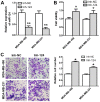MicroRNA‑124 suppresses cell proliferation and invasion of triple negative breast cancer cells by targeting STAT3
- PMID: 30896795
- PMCID: PMC6472193
- DOI: 10.3892/mmr.2019.10044
MicroRNA‑124 suppresses cell proliferation and invasion of triple negative breast cancer cells by targeting STAT3
Abstract
MicroRNAs (miRNAs) are pivotal regulators of the progression of carcinogenesis and negatively regulate the expression of tumour‑associated genes. Downregulation of miR‑124 expression has been demonstrated in various human cancer tissues, wherein miR‑124 serves as a tumour suppressor by targeting oncogenes. However, its function and underlying mechanism of action remain unclear in breast cancer. In the present study, the tissue‑specific expression of miR‑124 was detected in 10 paired triple‑negative breast cancer and normal tissues, and its inhibitory effects on cell growth and invasion were evaluated in vitro and in vivo. Bioinformatics analysis identified signal transducer and activator of transcription 3 (STAT3), a well‑known oncogene in breast cancer, as the potential target. Upregulation of miR‑124 expression decreased STAT3 mRNA and protein levels in breast cancer cells and the relative luciferase activity. Rescue experiments revealed that the transfection of a STAT3 expression plasmid reversed the inhibitory effect of miR‑124 on the proliferation and invasion of MDA‑MB‑468 cells. These data demonstrate that miR‑124 serves vital roles in the suppression of triple‑negative breast cancer via inhibition of cell proliferation and invasion through STAT3. These results highlight the potential role of miR‑124 as a diagnostic or therapeutic target in patients with breast cancer.
Figures







Similar articles
-
NEAT1/miR‑124/STAT3 feedback loop promotes breast cancer progression.Int J Oncol. 2019 Sep;55(3):745-754. doi: 10.3892/ijo.2019.4841. Epub 2019 Jul 15. Int J Oncol. 2019. PMID: 31322202
-
Long noncoding RNA SNHG14 promotes the aggressiveness of retinoblastoma by sponging microRNA‑124 and thereby upregulating STAT3.Int J Mol Med. 2020 Jun;45(6):1685-1696. doi: 10.3892/ijmm.2020.4547. Epub 2020 Mar 20. Int J Mol Med. 2020. Retraction in: Int J Mol Med. 2022 May;49(5):70. doi: 10.3892/ijmm.2022.5126. PMID: 32236565 Free PMC article. Retracted.
-
MicroRNA‑27a promotes tumorigenesis via targeting AKT in triple negative breast cancer.Mol Med Rep. 2018 Jan;17(1):562-570. doi: 10.3892/mmr.2017.7886. Epub 2017 Oct 26. Mol Med Rep. 2018. PMID: 29115608
-
STAT3 is involved in miR-124-mediated suppressive effects on esophageal cancer cells.BMC Cancer. 2015 Apr 19;15:306. doi: 10.1186/s12885-015-1303-0. BMC Cancer. 2015. PMID: 25928665 Free PMC article.
-
miR-199a-5p confers tumor-suppressive role in triple-negative breast cancer.BMC Cancer. 2016 Nov 14;16(1):887. doi: 10.1186/s12885-016-2916-7. BMC Cancer. 2016. PMID: 27842518 Free PMC article.
Cited by
-
Impact of microRNA variants on PI3K/AKT signaling in triple-negative breast cancer: comprehensive review.Med Oncol. 2024 Aug 9;41(9):222. doi: 10.1007/s12032-024-02469-4. Med Oncol. 2024. PMID: 39120634 Review.
-
Potential miRNAs for miRNA-Based Therapeutics in Breast Cancer.Noncoding RNA. 2020 Jul 13;6(3):29. doi: 10.3390/ncrna6030029. Noncoding RNA. 2020. PMID: 32668603 Free PMC article. Review.
-
The Effect of Terpenoid Natural Chinese Medicine Molecular Compound on Lung Cancer Treatment.Evid Based Complement Alternat Med. 2021 Dec 16;2021:3730963. doi: 10.1155/2021/3730963. eCollection 2021. Evid Based Complement Alternat Med. 2021. PMID: 34956377 Free PMC article. Review.
-
miR-124 and miR-203 synergistically inactivate EMT pathway via coregulation of ZEB2 in clear cell renal cell carcinoma (ccRCC).J Transl Med. 2020 Feb 11;18(1):69. doi: 10.1186/s12967-020-02242-x. J Transl Med. 2020. PMID: 32046742 Free PMC article.
-
Mapping the function of MicroRNAs as a critical regulator of tumor-immune cell communication in breast cancer and potential treatment strategies.Front Cell Dev Biol. 2024 Apr 25;12:1390704. doi: 10.3389/fcell.2024.1390704. eCollection 2024. Front Cell Dev Biol. 2024. PMID: 38726321 Free PMC article. Review.
References
MeSH terms
Substances
LinkOut - more resources
Full Text Sources
Miscellaneous

